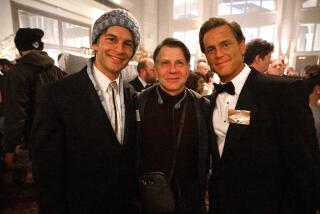Give This Guy a Foot and He Takes a Yard : FOOTSUCKER by Geoff Nicholson; Overlook Press $22.95, 224 pages
- Share via
Pity the foot fetishist. Unlike other varieties of sexual deviance, his particular kink doesn’t even earn the backhanded respect of visceral disgust and moral disapproval. It just makes people giggle.
“I perceive myself as a serious person,” says the unnamed narrator of Geoff Nicholson’s ninth novel, who has a “dull but responsible” job as a financial analyst in London. “I read newspapers. I follow politics. I try to keep up with the new books and films. . . . Yet I can see that there is something profoundly unserious” about being obsessed with women’s feet and shoes.
This bothers him a little, because foot fetishism, for him, is serious stuff indeed--so much so that in “Footsucker” we never see him engaged with his job or anything else that doesn’t involve toes and insteps, sling-backs and stiletto heels.
On the other hand, the goofiness of foot fetishism, the fact it is hard to take seriously, is a key element in his defense. Like Humbert Humbert’s lyrical but slippery account in Vladimir Nabokov’s “Lolita,” the granddaddy of sexual-deviance novels, this story is both a mea culpa and an assertion of innocence.
“I may be a fetishist but I’m not a sicko,” the narrator of “Footsucker” tells his American girlfriend, Catherine, who has, by his standards, perfect feet. And he appeals to us directly, arguing: “On the scale of human depravity and perversity,” foot fetishism “barely registered. There was no violence, no violation, no pain, no victim.”
We’re inclined to agree with him, at first. He’s intelligent, he has a sense of humor, he knows what Freud and Krafft-Ebing had to say about fetishism, how it peeks slyly out of scenes in famous movies. Above all, he seems to be a civilized chap--incapable, as he says, of hurting anyone.
Still, he does odd and sometimes offensive things. He steals shoes. He photographs women’s feet with a hidden camera. He stands outside shoe shops and poses as a researcher interviewing women on their preferences in footwear. (This is how he meets Catherine, who is aroused rather than upset by his increasingly intimate questions.) He collects exotic shoes and other fetish objects in a basement “archive.”
Nicholson keeps testing us, raising the stakes, forcing us to choose between the narrator’s world, in which everything he does makes some kind of sense, and the world of public opinion, in which it doesn’t.
The narrator is repelled when he meets a fellow fetishist whose taste in shoes he deplores. At a kinky London nightclub, he finds himself feeling “strangely illiberal. It wasn’t that I thought the membership . . . should be . . . persecuted because of their unusual sexual preferences, but I thought they should just keep them to themselves.”
Catherine feels a similar ambivalence. Despite enjoying their erotic high jinks and claiming to be uninterested in the conventional “romantic love thing,” she finds the narrator’s fetishism “unsettling” and finally leaves him for a photographer named Kramer. The narrator breaks into Kramer’s studio--not so civilized now--and is beaten up for his pains.
Then Kramer is murdered. The narrator is the prime suspect, though the murderer, we know, is really Harold Wilmer, an elderly custom shoemaker who has his own fixation on Catherine’s comely metatarsals.
The public world erupts into the private one with a vengeance when the narrator’s archive is scattered around a police station, eyed by sniggering cops, and an investigator is telling him that “one crime leads on inexorably to the next, like connecting the dots”--that, in the narrator’s words, he isn’t “a normal, healthy man with an intense but entirely sane sexual preference, but . . . some dodgy pervert, a thief and a liar . . . a murderer in the making.”
By now, the narrator has lost much of our sympathy, but society’s reaction is so cruel and irrational that he gets it back, as Nicholson intends. Like “Lolita,” this is supposed to be a love story. Whether we accept that or not--the happy ending seems forced--”Footsucker” remains a provocative and elegant meditation on a question that haunts many people (and not just sexual deviants, by any means): Am I Everyman or Everywoman, or a pathological case?
More to Read
Sign up for our Book Club newsletter
Get the latest news, events and more from the Los Angeles Times Book Club, and help us get L.A. reading and talking.
You may occasionally receive promotional content from the Los Angeles Times.










